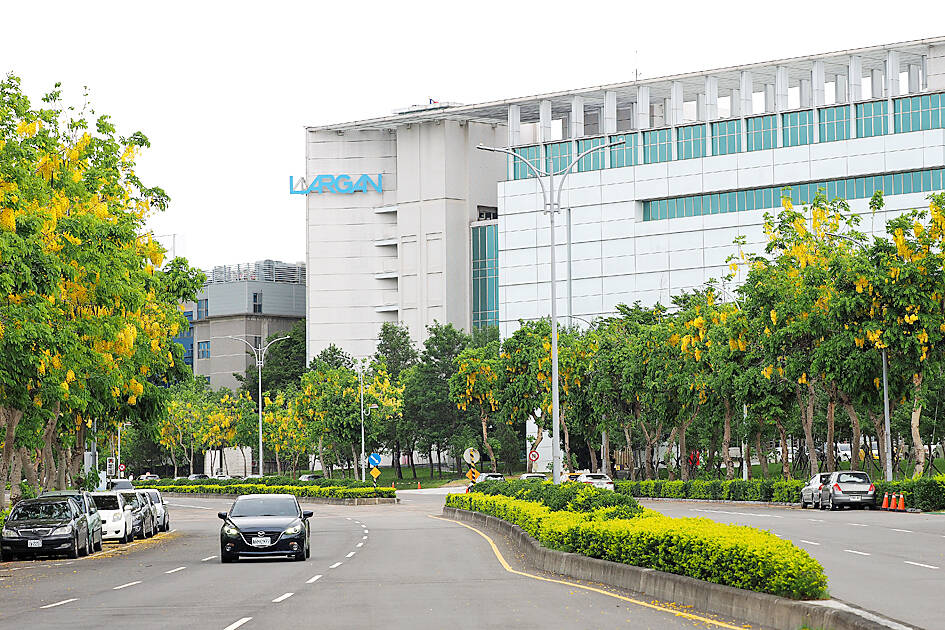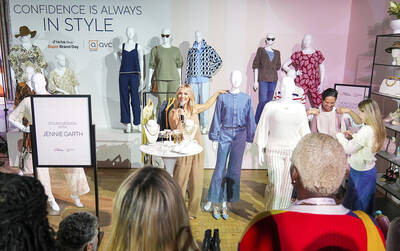Largan Precision Co (大立光) yesterday reported a 1.82 percent increase in consolidated revenue for last quarter from a year earlier to NT$18.21 billion (US$553.04 million), the fourth-highest for a single quarter in the company’s history, the nation’s largest handset camera lens maker said in a statement.
However, last quarter’s number declined 3.91 percent from the previous quarter’s record level, when revenue stood at NT$18.95 billion, as the industry entered its slow season, analysts said, adding that the decline was also the result of a reduced order by a US smartphone client.
Largan chief executive officer Adam Lin (林恩平) had already sounded a cautious note at an online investors’ conference on Oct. 17 last year, saying business performance in the December quarter would be weak due to order cuts by customers and the entry of new competitors.

Photo: David Chang, EPA-EFE
Still, Largan reported its second-highest revenue of NT$59.46 billion for the whole of last year, an annual growth of 21.73 percent and evidence that it remains a technology leader dominating the high-end smartphone market. The company achieved record revenue of NT$60.75 billion in 2019.
Largan’s core competency lies in the production of plastic lenses, which are widely used in smartphone cameras. The company has also developed hybrid lenses, which are plastic and glass lenses together.
The company said that revenue for this month would slide from last month’s NT$5.64 billion due to seasonal factors and disruption from the Lunar New Year, which falls on Jan. 29 this year.
Largan is to hold an investors’ conference on Thursday to release its earnings results for last quarter and give sales guidance for this quarter. The market would also focus on some key points, including whether gross margin and factory utilization rate could improve further, and the company’s plans for artificial intelligence solutions and advanced optical applications for high-end smartphones.
As various handset vendors continue to develop foldable phones, and Apple Inc is speculated to launch what might be its slimmest iPhone ever this year, which would greatly reduce the thickness of lenses and create barriers to entry in the industry — all pose positive to Largan’s profit outlook, analysts said.
The firm posted NT$17.24 billion in net profit during the first three quarters of last year, up 31.96 percent from a year earlier, with earnings per share of NT$129.16.

BYPASSING CHINA TARIFFS: In the first five months of this year, Foxconn sent US$4.4bn of iPhones to the US from India, compared with US$3.7bn in the whole of last year Nearly all the iPhones exported by Foxconn Technology Group (富士康科技集團) from India went to the US between March and last month, customs data showed, far above last year’s average of 50 percent and a clear sign of Apple Inc’s efforts to bypass high US tariffs imposed on China. The numbers, being reported by Reuters for the first time, show that Apple has realigned its India exports to almost exclusively serve the US market, when previously the devices were more widely distributed to nations including the Netherlands and the Czech Republic. During March to last month, Foxconn, known as Hon Hai Precision Industry

Taiwan Semiconductor Manufacturing Co (TSMC, 台積電) and the University of Tokyo (UTokyo) yesterday announced the launch of the TSMC-UTokyo Lab to promote advanced semiconductor research, education and talent development. The lab is TSMC’s first laboratory collaboration with a university outside Taiwan, the company said in a statement. The lab would leverage “the extensive knowledge, experience, and creativity” of both institutions, the company said. It is located in the Asano Section of UTokyo’s Hongo, Tokyo, campus and would be managed by UTokyo faculty, guided by directors from UTokyo and TSMC, the company said. TSMC began working with UTokyo in 2019, resulting in 21 research projects,

Ashton Hall’s morning routine involves dunking his head in iced Saratoga Spring Water. For the company that sells the bottled water — Hall’s brand of choice for drinking, brushing his teeth and submerging himself — that is fantastic news. “We’re so thankful to this incredible fitness influencer called Ashton Hall,” Saratoga owner Primo Brands Corp’s CEO Robbert Rietbroek said on an earnings call after Hall’s morning routine video went viral. “He really helped put our brand on the map.” Primo Brands, which was not affiliated with Hall when he made his video, is among the increasing number of companies benefiting from influencer

Quanta Computer Inc (廣達) chairman Barry Lam (林百里) yesterday expressed a downbeat view about the prospects of humanoid robots, given high manufacturing costs and a lack of target customers. Despite rising demand and high expectations for humanoid robots, high research-and-development costs and uncertain profitability remain major concerns, Lam told reporters following the company’s annual shareholders’ meeting in Taoyuan. “Since it seems a bit unworthy to use such high-cost robots to do household chores, I believe robots designed for specific purposes would be more valuable and present a better business opportunity,” Lam said Instead of investing in humanoid robots, Quanta has opted to invest